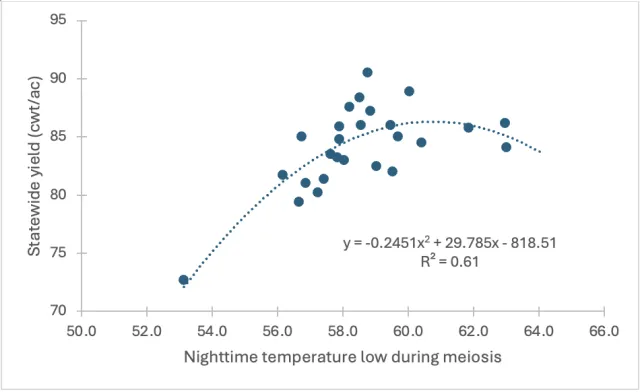I am resending this blog which is similar to one sent out a few weeks ago. I am looking at the current and extended weather forecast, and seeing low nighttime temperatures forecast for the last half of July. This is especially the case for the southern part of the Sacramento Valley. The data I am looking at is predicting an average low nighttime temperature of 56°F from July 16-30 at the Sacramento airport. Typically, we see low nighttime temperatures of 60°F during this period.
Low nighttime temperatures are a concern because blanking (floret sterility) can occur during meiosis (pollen formation) when they drop below 58°F. Blanking can cause reduced yields. The cooler it is and the more nights during this period with low temperatures have an increasingly negative effect. You can see in Figure 1, where in 1999, nighttime temperatures averaged 53°F during this period and yields averaged 73 cwt/ac. Based on the projected temperatures I mentioned above and the data provided in Figure 1, this could reduce yields by up to 5 cwt/ac.
This sensitive stage of pollen formation occurs during booting and is roughly between 7 days after panicle initiation (PI) and 7 days before flowering. While it depends on variety, this stage will begin around 55 to 60 days after planting. This year in California, the bulk of rice acreage was planted in mid-May. For this rice, pollen formation begin in mid-July and will continue to end of July (this is now for many rice growers this year).
To help alleviate this concern, we recommend raising the flood water height in your field to at least 6 to 8 inches. In Australia, where low nighttime temperatures are even a greater concern, they recommend 12 inches of water. The flood water will act as a blanket on the developing panicles and protect them for the low temperatures. Given the uncertainty of temperature forecasts and localized microclimates, we recommend raising the floodwater height between PI and flowering regardless – especially if you farm south of HWY 20.

Figure 1. Impact of low night time temperatures on California statewide yields. Data are from 1992 to 2023. Temperature data are an average of three CIMIS stations located in the rice growing region of Sacramento Valley. The temperature data presented represents the average low night time temperatures for a two-week period during meiosis.
